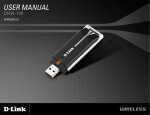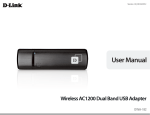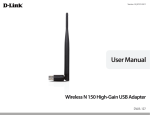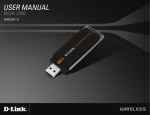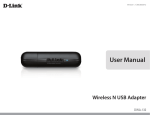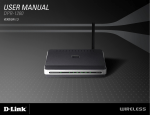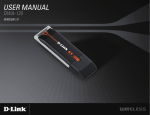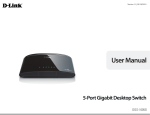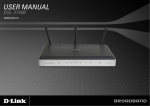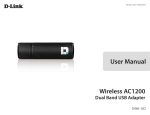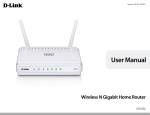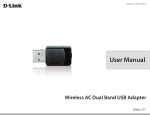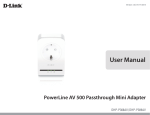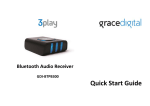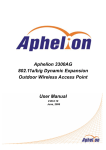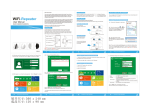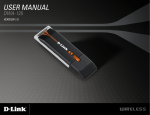Download D-Link GO-USB-N150 User Manual
Transcript
Table of Contents Table of Contents Product Overview............................................................... 3 Package Contents.......................................................................... 3 System Requirements.................................................................. 3 Introduction.................................................................................... 4 Features............................................................................................. 5 Hardware Overview...................................................................... 6 Installation.......................................................................... 7 Getting Started............................................................................... 7 Remove Existing Installations........................................... 7 Disable Other Adapters....................................................... 8 Wireless Installation Considerations.....................................10 Adapter Installation....................................................................11 Networking Basics............................................................31 Check your IP address................................................................31 Windows® XP Users.............................................................31 Windows® 7/Vista® Users..................................................31 Windows® 8 Users................................................................31 Statically Assign an IP Address...............................................32 Windows® XP Users.............................................................32 Windows® 7/ Vista® Users..................................................33 Windows® 8 Users................................................................34 Technical Specifications...................................................35 Connect to a Wireless Network........................................14 Wi-Fi® Protected Setup (WPS)..................................................14 Windows® 8....................................................................................15 Windows® 7....................................................................................17 Windows Vista®.............................................................................19 Windows® XP.................................................................................21 Troubleshooting...............................................................23 Wireless Basics..................................................................26 Wireless Modes.............................................................................30 D-Link GO-USB-N150 User Manual 2 Section 1 - Product Overview Product PackageOverview Contents D-Link GO-USB-N150 Wireless N 150 Easy USB Adapter CD with drivers and user manual Quick install Guide System Requirements • Windows® 8, 7, Vista®, or XP (32/64-bit) • CD-ROM Drive (must support 80mm Mini CD) • An 802.11n, 802.11g, wireless network • 20MB hard drive space • An available USB port D-Link GO-USB-N150 User Manual 3 Section 1 - Product Overview Introduction The GO-USB-N150 Wireless N 150 Easy USB Adapter is a convenient wireless connectivity solution for desktop or notebook PCs. Instead of stringing Ethernet cables to your PC or dismantling your desktop computer case, the GO-USB-N150 can enable 802.11n wireless connectivity by simply utilizing your desktop or notebook PC’s USB port. Powered by RangeBooster N® technology, the GO-USB-N150 provides a faster wireless connection and superior reception than 802.11g*. The GO-USB-N150 is designed for use in bigger homes and for those that demand higher bandwidth networking. Maximize wireless performance by connecting this USB Adapter to a Wireless N™ router and stay connected from virtually anywhere in the home. This USB Adapter supports WPA and WPA2 encryption to prevent outside intrusion and protect your personal information from being exposed.This USB Adapter supports WPA™ and WPA2™ encryption to prevent outside intrusion and protect your personal information from being exposed. * Maximum wireless signal rate derived from IEEE Standard 802.11g and 802.11n specifications. Actual data throughput will vary. Network conditions and environmental factors, including volume of network traffic, building materials and construction, and network overhead, lowers actual data throughput rate. Environmental conditions will adversely affect wireless signal range. D-Link GO-USB-N150 User Manual 4 Section 1 - Product Overview Features • Compact size for placement anywhere. • Fully 802.11g compatible. • 802.11n compliant. • Powered by the USB port; no external power source required. • USB 2.0 standard*. • You can securely connect to a wireless network using WPA™ / WPA2™ (Wi-Fi® Protected Access) providing you a much higher level of security for your data and communication than has previously been available. • Position the GO-USB-N150 almost anywhere in your workspace to achieve the best reception possible. • Supports Infrastructure networks via an access point or wireless router. * Using a USB 1.1 port will adversely affect throughput. D-Link GO-USB-N150 User Manual 5 Section 1 - Product Overview Hardware Overview 1 2 1 LED A blinking blue light indicates the adapter is installed and working correctly. A fast blinking light indicates the adapter is scanning for an available wireless network. If the light is off, the adapter is not properly installed. 2 WPS Button Press the WPS button to automatically connect to a WPS-enabled wireless router or access point and establish connectivity. Refer to page 15. D-Link GO-USB-N150 User Manual 6 Section 2 - Installation Installation This section will walk you through the installation process. If you have a built-in wireless adapter, please disable it in device manager before installing your D-Link adapter. Also, if you have previously installed another wireless adapter, please make sure any software is uninstalled. Getting Started Before installing your new D-Link wireless adapter, please verify the following: • Remove any previous installations of wireless adapters. • Disable any built-in wireless and Ethernet adapters. • Verify the settings such as the SSID and security settings of the network(s) you want to connect to. Remove Existing Installations If you’ve installed a different manufacture’s adapter or a different model D-Link adapter, make sure the software is uninstalled before installing the new software. Some utilities may cause a conflict with the new software. If you plan to use multiple adapters at different times, make sure the utilities are not set to load when your computer boots up. Windows® users may use the built-in wireless utility for all adapters. To remove any old software: Windows® 8 users: Press Windows Key + Q > Control Panel > Uninstall Programs. Windows® 7 users: Click Start > Control Panel > Uninstall Programs. Windows Vista® users: Click Start > Control Panel > Add or Remove Programs. Windows® XP users: Click Start > Control Panel > Add or Remove Programs. D-Link GO-USB-N150 User Manual 7 Section 2 - Installation Disable Other Adapters Most newer laptops may include a built-in wireless adapter. To prevent any conflicts with the D-Link wireless adapter, it is recommended to disable the wireless adapter (as well as any unused Ethernet adapters). Windows XP - Go to Start > My Computer > Properties > Hardware > Device Manager. Windows Vista/7 - Go to Start > Device Manager. Windows 8 - Press the Windows key and X together and then click Device Manager. Click the Hardware tab and then click Device Manager. Scroll down the list and click the + sign to the left of Network Adapters. Right-click the adapter you would like to disable and select Disable. D-Link GO-USB-N150 User Manual 8 Section 2 - Installation Click Yes to disable the adapter. When the adapter is disabled, a down arrow or a grayed icon will be displayed. Disabling the adapter will not remove the drivers. If you would like to use the adapter, simply right-click it and select Enable. D-Link GO-USB-N150 User Manual 9 Section 2 - Installation Wireless Installation Considerations The D-Link wireless adapter lets you access your network using a wireless connection from virtually anywhere within the operating range of your wireless network. Keep in mind, however, that the number, thickness and location of walls, ceilings, or other objects that the wireless signals must pass through, may limit the range. Typical ranges vary depending on the types of materials and background RF (radio frequency) noise in your home or business. The key to maximizing wireless range is to follow these basic guidelines: 1. Keep the number of walls and ceilings between the D-Link adapter and other network devices to a minimum - each wall or ceiling can reduce your adapter’s range from 3-90 feet (1-30 meters.) Position your devices so that the number of walls or ceilings is minimized. 2. Be aware of the direct line between network devices. A wall that is 1.5 feet thick (.5 meters), at a 45-degree angle appears to be almost 3 feet (1 meter) thick. At a 2-degree angle it looks over 42 feet (14 meters) thick! Position devices so that the signal will travel straight through a wall or ceiling (instead of at an angle) for better reception. 3. Building materials make a difference. A solid metal door or aluminum studs may have a negative effect on range. Try to position access points, wireless routers, and computers so that the signal passes through drywall or open doorways. Materials and objects such as glass, steel, metal, walls with insulation, water (fish tanks), mirrors, file cabinets, brick, and concrete will degrade your wireless signal. 4. Keep your product away (at least 3-6 feet or 1-2 meters) from electrical devices or appliances that generate RF noise. 5. If you are using 2.4GHz cordless phones or X-10 (wireless products such as ceiling fans, lights, and home security systems), your wireless connection may degrade dramatically or drop completely. Make sure your 2.4GHz phone base is as far away from your wireless devices as possible. The base transmits a signal even if the phone in not in use. D-Link GO-USB-N150 User Manual 10 Section 2 - Installation Adapter Installation Warning: Do NOT connect the GO-USB-N150 Wireless N 150 Easy USB Adapter to your computer before installing the driver software from the D-Link CD. Turn on the computer and insert the D-Link GO-USB-N150 Driver CD in the CD-ROM drive. If the CD Autorun function does not automatically start on your computer, go to Start > Run. In the run box type “D:\autorun.exe” (where D: represents the drive letter of your CD-ROM drive). When the autorun screen appears, click Install. D-Link GO-USB-N150 User Manual 11 Section 2 - Installation The InstallShield Wizard window will appear. Once the Welcome screen appears, click Next to continue. Connect the GO-USB-N150 adapter to an available USB slot on your computer. Click Next to continue. D-Link GO-USB-N150 User Manual 12 Section 2 - Installation Your GO-USB-N150 adapter is now installed. D-Link GO-USB-N150 User Manual 13 Section 3 - Connect to a Wireless Network Connect to a Wireless Network Wi-Fi® Protected Setup (WPS) Wi-Fi Protected Setup (WPS) System is designed for easy setup of security-enabled Wi-Fi networks. It is recommended to have the access point or wireless router nearby during setup. “Push Button Configuration” (PBC) is a physical button on the GO-USB-N150 and most wireless devices such as routers. A connection can be established by pressing the WPS button on the GO-USB-N150 and then pushing the button on your access point or wireless router within 120 seconds. 1. Press the WPS button located on your wireless router or access point. Please refer to the user manual of your router or access point if you do not know how to start the WPS process. D-Link GO-USB-N150 User Manual 2. To connect to your network, press the WPS button on the adapter and hold for two seconds. Allow up to two minutes for the devices to connect. 14 Section 3 - Connect to a Wireless Network Windows® 8 1. Click on the wireless computer icon in your system tray (lower-right corner next to the time). 2. A list of available wireless networks will appear. 3. Click the wireless network (SSID) you want to connect to and then click Connect. 4. If the network is secure/encrypted, enter the Wi-Fi password (security key) and click Next. D-Link GO-USB-N150 User Manual 15 Section 3 - Connect to a Wireless Network 5. Click either to enable or disable file sharing. 6. You will now be connected to your wireless network. If you get a good signal but cannot access the Internet, confirm the encryption by reviewing the profile or check the TCP/IP settings for your wireless adapter. Refer to the Networking Basics section in this manual for more information. D-Link GO-USB-N150 User Manual 16 Section 3 - Connect to a Wireless Network Windows® 7 1. Click on the wireless icon in your system tray (lower-right corner). 2. The utility will display any available wireless networks in your area. D-Link GO-USB-N150 User Manual 17 Section 3 - Connect to a Wireless Network 3. Highlight the wireless network (SSID) you would like to connect to and click the Connect button. If you get a good signal but cannot access the Internet, check your TCP/IP settings for your wireless adapter. Refer to the Networking Basics section in this manual for more information. 4. Enter the same security key or passphrase that is on your router and click Connect. You can also connect by pushing the WPS button on the router. It may take 20-30 seconds to connect to the wireless network. If the connection fails, please verify that the security settings are correct. The key or passphrase must be exactly the same as on the wireless router. D-Link GO-USB-N150 User Manual 18 Section 3 - Connect to a Wireless Network Windows Vista® 1. Open the Wireless Utility by right-clicking on the wireless computer icon in your system tray (lower right corner of screen). Select Connect to a network. 2. Highlight the wireless network (SSID) you would like to connect to and click Connect. D-Link GO-USB-N150 User Manual 19 Section 3 - Connect to a Wireless Network 3. Enter the same security key or passphrase that is on your router and click Connect. It may take 20-30 seconds to connect to the wireless network. If the connection fails, please verify that the security settings are correct. The key or passphrase must be exactly the same as on the wireless router. D-Link GO-USB-N150 User Manual 20 Section 3 - Connect to a Wireless Network Windows® XP 1. Open the Windows XP Wireless Utility by right-clicking on the wireless computer icon in your system tray (lower-right corner of screen). Select View Available Wireless Networks. 2. Highlight the wireless network (SSID) you would like to connect to and click Connect. D-Link GO-USB-N150 User Manual 21 Section 3 - Connect to a Wireless Network 3. The Wireless Network Connection box will appear. Enter the WPA/WPA2-Personal passphrase and click Connect. It may take 20-30 seconds to connect to the wireless network. If the connection fails, please verify that the WPA/WPA2-Personal settings are correct. The WPA/WPA2-Personal passphrase must be exactly the same as on the wireless router or access point. D-Link GO-USB-N150 User Manual 22 Section 4 - Troubleshooting Troubleshooting This chapter provides solutions to problems that can occur during the installation and operation of the GO-USB-N150. Read the following descriptions if you are having problems. 1. How do I know if my adapter is installed properly? Windows XP - Go to Start > My Computer > Properties > Hardware > Device Manager. Windows Vista/7 - Go to Start > Device Manager. Windows 8 - Press the Windows key and X together and then click Device Manager. D-Link GO-USB-N150 User Manual 23 Section 4 - Troubleshooting Click the + sign next to Network Adapters. Right-click on D-Link GO-USB-N150 Wireless N 150 Easy USB Adapter. Select Properties to check that the drivers are installed properly. Look under Device Status to check that the device is working properly. Click OK to continue. D-Link GO-USB-N150 User Manual 24 Section 4 - Troubleshooting 2. The computer does not recognize the GO-USB-N150 Wireless Adapter. Make sure that the GO-USB-N150 Wireless Adapter is properly seated in the computer’s USB port. If Windows® does not detect the hardware upon insertion of the adapter, make sure to completely remove drivers that were previously loaded. 3. The computer with the GO-USB-N150 installed is unable to connect to the wireless network and/or the Internet. • Check that the LED indicators for the broadband modem are indicating normal activity. If not, there may be a problem with the broadband connection. • Check that the LED indicators on the wireless router are functioning properly. If not, check that the AC power and Ethernet cables are firmly connected. • Check that the IP Address, subnet mask, gateway, and DNS settings are correctly entered for the network • In Infrastructure mode, make sure the same Service Set Identifier (SSID) is specified on the settings for the wireless clients and access points. By default, the SSID factory setting for D-Link products is blank. (Double-click on the WLAN icon in the taskbar. The Link Info screen will display the SSID setting.) D-Link GO-USB-N150 User Manual 25 Appendix A - Wireless Basics Wireless Basics D-Link wireless products are based on industry standards to provide easy-to-use and compatible high-speed wireless connectivity within your home, business or public access wireless networks. Strictly adhering to the IEEE standard, the D-Link wireless family of products will allow you to securely access the data you want, when and where you want it. You will be able to enjoy the freedom that wireless networking delivers. A wireless local area network (WLAN) is a cellular computer network that transmits and receives data with radio signals instead of wires. Wireless LANs are used increasingly in both home and office environments, and public areas such as airports, coffee shops and universities. Innovative ways to utilize WLAN technology are helping people to work and communicate more efficiently. Increased mobility and the absence of cabling and other fixed infrastructure have proven to be beneficial for many users. Wireless users can use the same applications they use on a wired network. Wireless adapter cards used on laptop and desktop systems support the same protocols as Ethernet adapter cards. Under many circumstances, it may be desirable for mobile network devices to link to a conventional Ethernet LAN in order to use servers, printers or an Internet connection supplied through the wired LAN. A Wireless Router is a device used to provide this link. D-Link GO-USB-N150 User Manual 26 Appendix A - Wireless Basics What is Wireless? Wireless or Wi-Fi® technology is another way of connecting your computer to the network without using wires. Wi-Fi uses radio frequency to connect wirelessly, so you have the freedom to connect computers anywhere in your home or office network. Why D-Link Wireless? D-Link is the worldwide leader and award winning designer, developer, and manufacturer of networking products. D-Link delivers the performance you need at a price you can afford. D-Link has all the products you need to build your network. How does wireless work? Wireless works similar to how cordless phone work, through radio signals to transmit data from one point A to point B. But wireless technology has restrictions as to how you can access the network. You must be within the wireless network range area to be able to connect your computer. There are two different types of wireless networks Wireless Local Area Network (WLAN), and Wireless Personal Area Network (WPAN). Wireless Local Area Network (WLAN) In a wireless local area network, a device called an Access Point (AP) connects computers to the network. The access point has a small antenna attached to it, which allows it to transmit data back and forth over radio signals. With an indoor access point, the signal can travel up to 300 feet. With an outdoor access point the signal can reach out up to 30 miles to serve places like manufacturing plants, industrial locations, college and high school campuses, airports, golf courses, and many other outdoor venues. Wireless Personal Area Network (WPAN) Bluetooth® is the industry standard wireless technology used for WPAN. Bluetooth devices in WPAN operate in a range up to 30 feet away. Compared to WLAN the speed and wireless operation range are both less than WLAN, but in return it doesn’t use nearly as much power which makes it ideal for personal devices, such as mobile phones, PDAs, headphones, laptops, speakers, and other devices that operate on batteries. D-Link GO-USB-N150 User Manual 27 Appendix A - Wireless Basics Who uses wireless? Wireless technology has become so popular in recent years that almost everyone is using it, whether it’s for home, office, or business, D-Link has a wireless solution for it. Home • Gives everyone at home broadband access • Surf the web, check email, instant message, and etc • Gets rid of the cables around the house • Simple and easy to use Small Office and Home Office • Stay on top of everything at home as you would at the office • Remotely access your office network from home • Share an Internet connection and printer with multiple computers • No need to dedicate office space D-Link GO-USB-N150 User Manual 28 Appendix A - Wireless Basics Where is wireless used? Wireless technology is expanding everywhere not just at home or the office. People like the freedom of mobility and it’s becoming so popular that more and more public facilities now provide wireless access to attract people. The wireless connection in public places is usually called “hotspots”. Using a D-Link USB Adapter with your laptop, you can access the hotspot to connect to the Internet from remote locations like: Airports, Hotels, Coffee Shops, Libraries, Restaurants, and Convention Centers. Wireless networks are easy to setup, but if you’re installing it for the first time it could be quite a task not knowing where to start. That’s why we’ve put together a few setup steps and tips to help you through the process of setting up a wireless network. Tips Here are a few things to keep in mind, when you install a wireless network. Centralize your router or Access Point Make sure you place the router/access point in a centralized location within your network for the best performance. Try to place the router/access point as high as possible in the room, so the signal gets dispersed throughout your home. If you have a twostory home, you may need a repeater to boost the signal to extend the range. Eliminate Interference Place home appliances such as cordless telephones, microwaves, and televisions as far away as possible from the router/access point. This can significantly reduce any interference that the appliances might cause since they operate on the same frequency. Security Don’t let your next-door neighbors or intruders connect to your wireless network. Secure your wireless network by turning on WPA™/WPA2™ security features on the router. Refer to the product manual for detailed information on how to set it up. D-Link GO-USB-N150 User Manual 29 Appendix A - Wireless Basics Wireless Modes There are basically two modes of networking: • Infrastructure – All wireless clients will connect to an access point or wireless router. • Ad-Hoc – Directly connecting to another computer, for peer-to-peer communication, using wireless network adapters on each computer. An Infrastructure network contains an Access Point or wireless router. All the wireless devices, or clients, will connect to the wireless router or access point. An Ad-Hoc network contains only clients, such as laptops with wireless USB Adapters. All the adapters must be in Ad-Hoc mode to communicate. D-Link GO-USB-N150 User Manual 30 Appendix B - Networking Basics Networking Basics Check your IP address After you install your new D-Link wireless adapter and have established a wireless connection, by default, the TCP/IP settings should be set to obtain an IP address from a DHCP server (i.e., router) automatically. To verify your IP address, please follow the steps below. Windows® XP Users • Click on Start > Run. In the run box type cmd and click OK. • At the prompt, type ipconfig and press Enter. • This will display the IP address, subnet mask, and the default gateway of your adapter. Windows® 7/Vista® Users • Click Start, type cmd in the search box and then click OK. • At the prompt, type ipconfig and press Enter. • This will display the IP address, subnet mask, and default gateway of your adapter. Windows® 8 Users • Press the Windows key and R together. Type cmd in the box and click OK. • At the prompt, type ipconfig and press Enter. • This will display the IP address, subnet mask, and default gateway of your adapter. If the address is 0.0.0.0, check your adapter installation, security settings, and the settings on your router. Some firewall software programs may block a DHCP request on newly installed adapters. D-Link GO-USB-N150 User Manual 31 Appendix B - Networking Basics Statically Assign an IP Address If you are not using a DHCP capable gateway/router, or you need to assign a static IP address, please follow the steps below: Windows® XP Users • Click on Start > Control Panel. Make sure you are in Classic View. Double-click on the Network Connections icon. • Right-click on the Local Area Connection which represents your D-Link wireless network adapter (or other adapter) which will be connected to your router. • Highlight Internet Protocol (TCP/IP) and click Properties. • Click Use the following IP address and enter an IP address that is on the same subnet as your network or LAN IP address on your router. Example: If the router’s LAN IP address is 192.168.0.1, make your IP address 192.168.0.X where X is a number between 2 and 99. Make sure that the number you choose is not in use on the network. • Set Default Gateway the same as the LAN IP address of your router or gateway. • Set Primary DNS as the LAN IP address of your router or gateway. • The Secondary DNS is optional (you may enter a DNS server from your ISP). • Click OK to save your settings. D-Link GO-USB-N150 User Manual 32 Appendix B - Networking Basics Windows® 7/ Vista® Users • Click on Start > Control Panel (make sure you are in Classic View). Double-click on the Network and Sharing Center icon. If you are using Windows Vista, click on Manage network connections along the left panel in the window. For Windows® 7, click on Change adapter settings. • Right-click on the Local Area Connection which represents your D-Link wireless network adapter which will be connected to your network. • Highlight Internet Protocol Version 4 (TCP /IPv4) and click Properties. • Click Use the following IP address and enter an IP address that is on the same subnet as your network or LAN IP address on your router or network. Example: If the router’s LAN IP address is 192.168.0.1, make your IP address 192.168.0.X where X is a number between 2 and 99. Make sure that the number you choose is not in use on the network. • Set Default Gateway the same as the LAN IP address of your router or gateway. • Set Primary DNS the same as the LAN IP address of your router or gateway. • The Secondary DNS is optional (you may enter a DNS server from your ISP). • Click OK to save your settings. D-Link GO-USB-N150 User Manual 33 Appendix B - Networking Basics Windows® 8 Users • Press the Windows key and then type IP. Click Settings on the right side and then click View Network Connections. • Right-click on the adapter which represents your D-Link wireless network adapter. • Highlight Internet Protocol Version 4 (TCP /IPv4) and click Properties. • Click Use the following IP address and enter an IP address that is on the same subnet as your network or LAN IP address on your router or network. Example: If the router’s LAN IP address is 192.168.0.1, make your IP address 192.168.0.X where X is a number between 2 and 99. Make sure that the number you choose is not in use on the network. • Set Default Gateway the same as the LAN IP address of your router or gateway. • Set Primary DNS the same as the LAN IP address of your router or gateway. • The Secondary DNS is optional (you may enter a DNS server from your ISP). • Click OK to save your settings. D-Link GO-USB-N150 User Manual 34 Appendix C - Technical Specifications Technical Specifications Standards • IEEE 802.11n • IEEE 802.11g Bus Type • USB 2.0 (1.1 compatible) Security • WPA™/WPA2™ - Wi-Fi Protected Access • WPS (PBC) Frequency Range • 2.4GHz to 2.483GHz Modulation Technology • Orthogonal Frequency Division Multiplexing (OFDM) • Complementary Code Keying (CCK) Operating Temperature • 32°F to 104°F ( 0°C to 40°C) Operating Humidity • 10% to 90% maximum (non-condensing) Dimensions • 69.89 mm x 18.37 mm x 10.8 mm Weight • 12g Certifications • CE • Wi-Fi® Warranty • 2 Years Operating Voltage • 5 VDC +/- 10% * Maximum wireless signal rate derived from IEEE Standard 802.11n and 802.11g specifications. Actual data throughput will vary. Network conditions and environmental factors, including volume of network traffic, building materials and construction, and network overhead, lower actual data throughput rate. Environmental factors will adversely affect wireless signal range. D-Link GO-USB-N150 User Manual 35



































